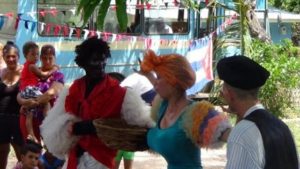Almost all the Cuban Teatro Bufo arguments are based on three characters: black, Galician and mulata, which the bourgeois atmosphere of colonial Cuba satirizes and will affirm the genuine values of the working classes. Then is you would add another character: the chinito, attending to the then growing colony Chinese in Cuba.
The concurrence of the music, the mood in the particular form of the Cuban herencia13, the preponderance of the interpreter and its special relationship with the public, were the elements that contributed to give a style to this theatrical expression.
Were several those actors that is highlighted in its interpretation of the bold in the vernacular Cuban. Interpretations of the Pous – uncle and nephew–are remembered. Also on the Espigul – father and son, who inaugurated the style of the nutty sketch, some of which, such as the spiritualist, in which black man speaks whistling all the time, were recorded for history. The hint and Sergio Acebal is reputed to be one of the best all-time negritos. Enrique Arredondo was the latest bold.
Alberto Garrido is the big bold of the scene Cuban, title that only Acebal you discussed. Legitimate fruit of the theatre, was the son of another black man that widely surpassed. She danced with an unsurpassed grace. And not only rumba.
https://youtu.be/jaqXb3PIZQ4
In the Martí theater, entrepreneurs demanding writers who in his works demorasen Garrido exit scene, because once it appeared it stole the show. In a work that Enrique Núñez Rodríguez wrote so Garrido it interpreted in the Martí, delayed, as was planned, the output of the actor. Did not appear until the third frame. The work progressed without him and viewers costaricans. Of soon, between boxes, you heard the voice of Garrido. He sang «Gone los guapos in Yateras». That was the last straw. The actors that were on scene in that moment made mutis and although not was visible, the public applauded to Alberto Garrido during 15 minutes. So the work could continue, scene boss ordered him to come out to say hello. It applauded then during 18 minutes more.
During the early decades of the 20th century, black, Galician and the mulata were, like characters, fixed point in the vernacular theatre. His long tenure at the scene shows the frank and cordial reception which dispensed them the public. Those three guys found brilliant actors and actresses who interpret them and which became true idols of the public capital and the rest of the country.
Despite the welcome that had, his presence continued deserved the reproach of authors without public and critical sophisticated, say specialists. Of the three was black the most attacked and launched advertising campaigns for their total exclusion from the vernacular. They said his detractors that the negro was discriminated against in the scene.
In the view of many, it was never so. By the opposite. The negrito, a white actor with the tiznada face, was a kind and sympathetic, «alive», character who not took to discover the ins and outs of an event and make clear the truth. Time it was carefree and refistolero. Or filosofo and Professor. Or naive and simpleton. But it never appeared as the bad work and much less as a despicable kind.
https://youtu.be/AinwuGiOt60
Galician was often victim of the antics of the negrito and there were works in which this birlara you to the mulatto with which the Galician noviaba. All of that with the complacency of the Spanish public that attended the theatre, which laughed the scene happened perhaps thinking to herself that on more than one occasion these same things had happened. The dialogues of the uncle and nephew, funny and witty, were faithful reflection of things happening every day in the trastiendas-thru of the wineries.
Like the bold, Galician had outstanding performers. Let’s mention Regino López and his brother Pirolo, Federico Piñero, Adolfo Otero, Américo Castellanos, Idalberto Delgado, Juan Carlos Romero. Among the nephews, Andrés Rubio, and Manolín Álvarez.
The mulatto of breaks and tears complete the trilogy of the favorite characters of the vernacular. They were, in general, women’s humble birthplace. Stranded in his childhood and adolescence and that already in his youth became real beasts in order to defend his honour. Admirers, disturbing them among them those of the wealthy class, and between jokes and jokes were respected. As Luz Gil said, «respect Me because I have the well secured saya». The actress who interpreted the mulatto, because he should sing and dance very well should be very complete.
Some authors reflects the Luz Gil, despite its Mexican origin, as the most complete mulata in the genre. Others were Blanca Vázquez, Conchita Llauradó, Mimí Cal and the exceptional Candita Quintana, top figure of the vernacular for more than 40 years. All them without forgetting us of Aurora Basnuevo, the incomparable «mulatisima».
Agencies/Wiki/Internet Photos/YouTube/Arnold Varona/TheCubanHistory.com
The Cuban History, Hollywood.
![]() Personajes Cubanos: “El Negro, El Gallego y La Mulata.
Personajes Cubanos: “El Negro, El Gallego y La Mulata.
Casi todos los argumentos del Teatro Bufo Cubano se basan en tres personajes: el negro, el gallego y la mulata, mediante los cuales se satiriza el ambiente burgués de la Cuba colonial y se afirman los genuinos valores de las clases populares. Después se le incorporaría otro personaje: el chinito, atendiendo a la entonces creciente colonia china en Cuba.
La concurrencia de la música, del humor en la particular forma del choteo cubano, la preponderancia del intérprete y su especial relación con el público, fueron los elementos que contribuyeron a dotar de un estilo a esta expresión teatral.
Fueron varios los actores que se destacaron en su interpretación del negrito en el vernáculo cubano. Son recordadas las interpretaciones de los Pous —tío y sobrino—. También las de los Espígul —padre e hijo—, que inauguraron el estilo del sketch chiflado, algunos de los cuales, como El espiritista, en que el negrito habla chiflando todo el tiempo, quedaron grabados para la historia. El ya aludido Sergio Acebal tiene fama de ser uno de los mejores negritos de todos los tiempos. Enrique Arredondo fue el último negrito.
Alberto Garrido es el gran negrito de la escena cubana, título que solo Acebal le discute. Fruto legítimo del teatro, era hijo de otro negrito al que superó ampliamente. Bailaba con una gracia insuperable. Y no solo rumba.
En el Teatro Martí, los empresarios exigían a los escritores que en sus obras demorasen la salida de Garrido a escena, porque una vez que aparecía se robaba el espectáculo. En una obra que Enrique Núñez Rodríguez escribió para que Garrido la interpretara en el Martí, demoró, como estaba previsto, la salida del actor. No aparecía hasta el tercer cuadro. La obra avanzaba sin él y los espectadores se impacientaban. De pronto, entre cajas, se escuchó la voz de Garrido. Cantaba «Se acabaron los guapos en Yateras». Aquello fue el acabose. Los actores que estaban en escena en ese momento hicieron mutis y aunque no resultaba visible, el público aplaudió a Alberto Garrido durante 15 minutos. Para que la obra pudiera proseguir, el jefe de escena le ordenó que saliera a saludar. Lo aplaudieron entonces durante 18 minutos más.
Durante las décadas iniciales del siglo XX, el negro, el gallego y la mulata fueron, como personajes, punto fijo en el teatro vernáculo. Su larga permanencia en la escena demuestra la franca y cordial acogida que les dispensó el público. Esos tres tipos encontraron brillantes actores y actrices que los interpretaran y que llegaron a ser verdaderos ídolos del público capitalino y del resto del país.
Pese a la acogida que tuvieron, su presencia continuada mereció la reprobación de autores sin público y críticos sofisticados, afirman especialistas. De los tres fue el negro el más atacado y se lanzaron campañas publicitarias para su total exclusión del vernáculo. Decían sus detractores que el negro era discriminado en la escena.
A juicio de muchos, nunca fue así. Por el contrario. El negrito, un actor blanco con la cara tiznada, era un personaje bueno y simpático, «vivo», que no tardaba en descubrir las interioridades de un suceso y poner en claro la verdad. En ocasiones era desenfadado y refistolero. O filosofón y catedrático. O ingenuo y bobalicón. Pero nunca apareció como el malo de la obra y mucho menos como un tipo deleznable.
El gallego era por lo general víctima de las trastadas del negrito y no faltaban obras en las que este le birlara a la mulata con la que el gallego noviaba. Todo eso con la complacencia del público español que asistía al teatro, el cual reía los sucedidos de la escena pensando tal vez para sus adentros que en más de una ocasión esas mismas cosas le habían ocurrido. Los diálogos del tío y el sobrino, graciosos y ocurrentes, eran fiel reflejo de las cosas que a diario sucedían en las trastiendas de las bodegas.
Al igual que el negrito, el gallego tuvo intérpretes sobresalientes. Mencionemos a Regino López y su hermano Pirolo, Federico Piñero, Adolfo Otero, Américo Castellanos, Idalberto Delgado, Juan Carlos Romero. Entre los sobrinos, Andrés Rubio y Manolín Álvarez.
La mulata de rompe y rasga completa la trilogía de los personajes preferidos del vernáculo. Eran, por lo general, mujeres de cuna humilde. Desamparadas en su infancia y adolescencia y que ya en su juventud se convertían en verdaderas fieras con tal de defender su honra. Les sobraban los admiradores, entre ellos los de la clase pudiente, y entre bromas y chanzas se hacían respetar. Como decía Luz Gil, «Me respetan porque tengo la saya bien amarrada». Debía ser muy completa la actriz que interpretase a la mulata, pues debía cantar y bailar muy bien.
A Luz Gil, pese a su origen mexicano, algunos autores la conceptúan como la mulata más completa en el género. Otras fueron Blanca Vázquez, Conchita Llauradó, Mimí Cal y la excepcional Candita Quintana, primerísima figura del vernáculo por más de 40 años. Todas ellas sin olvidarnos de Aurora Basnuevo, la incomparable «mulatísima».
Agencies/Wiki/Internet Photos/YouTube/Arnoldo Varona/TheCubanHistory.com
The Cuban History, Hollywood.







